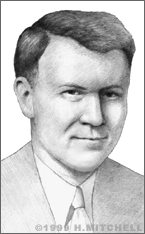Waldo Semon
Waldo Semon took a detour in his assigned laboratory research one day and ended up inventing the world’s second-best-selling plastic: polyvinyl chloride, a.k.a. PVC, a.k.a. vinyl.
Semon was born on September 10, 1898 in Demopolis, Alabama, but moved with his family when he was seven to Washington State. In 1916, he entered one of the two institutions where he would spend most of his career: the University of Washington, in Seattle. Semon planned to become a chemist and did. In 1920, he graduated cum laude with a BS in Chemistry. Just three years later, he earned his PhD (1923). He taught as an Instructor for a few more years, until he was lured away by the company that became his second professional home, BFGoodrich (1926).
Semon’s recruiter was a former mentor at UW, Harry Trumbull. Trumbull had become BFG’s Head of Chemical Research since 1919, and in the mid-1920s was working on a process to coat metal with rubber. Trumbull believed this could best be accomplished with a synthetic, rather than natural, rubber, and he hired Semon to solve the problem.
Semon arrived in Akron, Ohio, in the summer of 1926. His first attempts, using reclaimed crude rubber and a German prototype of synthetic rubber, were unsuccessful. When Semon had run through all his rubber supplies, he began experimenting with synthetic organic polymers --- including polyvinyl chloride, or PVC, a substance at that time considered to be no more valuable than refuse. Because the polymer was stiff at room temperature, Semon heated it in a solvent with a high boiling point: the result was a jelly that was elastic after cooling, but was not adhesive.
Semon instinctively realized that he was halfway to a major breakthrough. Sidelining his original assignment, he kept experimenting with the elasticized PVC, until he succeeded, “by accident” as he later claimed, in plasticizing the substance. PVC was always more durable than crude rubber; Semon’s first breakthrough made it elastic as well as resilient; and his second breakthrough made it moldable into whatever shape was required. Semon’s first applications included, predictably, shoe soles, as well as a number of useful coatings, for tool handles, wire, and other items.
The second great characteristic of Semon’s substance, after its tremendous versatility, is that it is very inexpensive to make: processes and additives aside, PVC is made of sea water and petroleum. By the 1930s, BFGoodrich had begun to produce and market the first of the hundreds of commercial applications that would be found for plasticized PVC. In the ‘40s and ‘50s, BFGoodrich somehow lost its leadership in the industry, as “vinyl” became a commonplace material. In 1993, BFG’s Vinyl Division split off to become an independent corporation, Geon. Meanwhile, vinyl remains the second most common plastic in the world, the source of billions of dollars of revenue every year.
Semon never rested on his laurels in the lab. In fact, by 1934, he had overachieved in the task Trumbull had originally set him, inventing over a hundred methods of affixing synthetic rubber to metal. In time, Semon became Director of Research and led teams that invented other families of plastics. In total, Semon himself earned 116 U.S. patents.
After he retired from BFGoodrich in 1963, Waldo Semon was a Research Professor at nearby Kent State University for many years. Moreover, he was known throughout his career for his devotion to education, and his frequent support of science education at schools in and around Akron. He died in 1999 at the age of 100.


